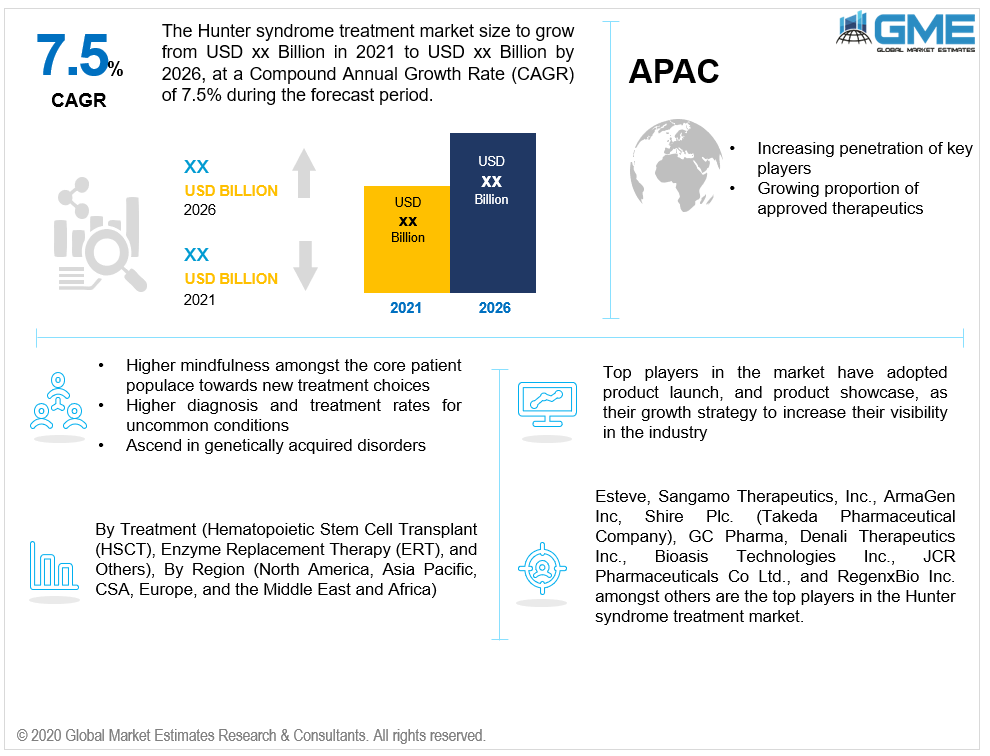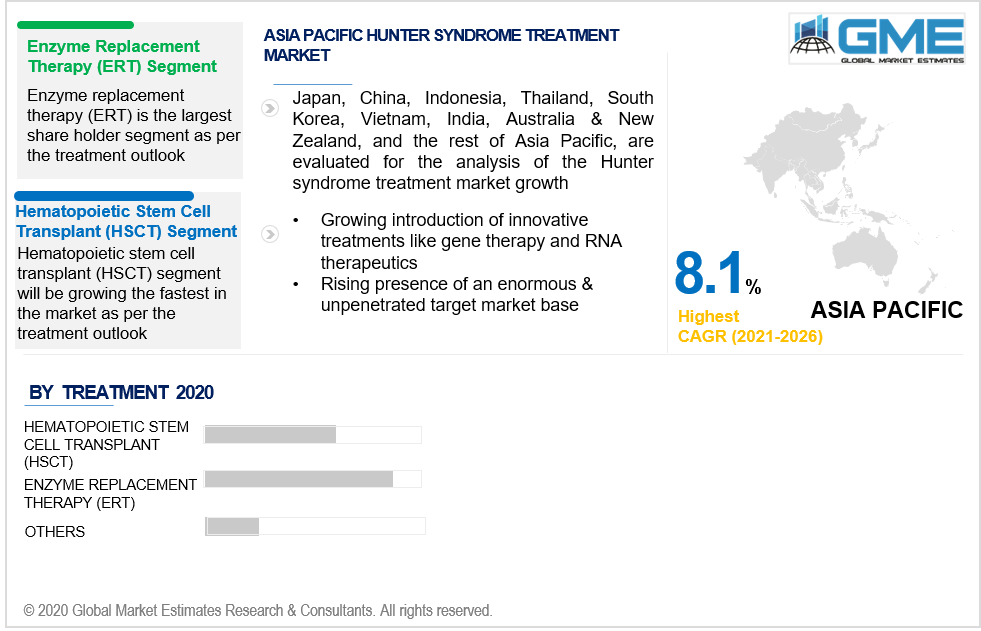
Global Hunter Syndrome Treatment Market Size, Trends & Analysis - Forecasts to 2026 By Treatment (Hematopoietic Stem Cell Transplant (HSCT), Enzyme Replacement Therapy (ERT), and Others), Competitive Landscape, Company Market Share Analysis, and Competitor Analysis
Hunter Syndrome, often regarded as Mucopolysaccharidosis type II (MPS II), is a genetic complication, which is more common amongst the male demographics. Males possess an X and Y chromosome, and this disease is caused by an inactive X chromosome, which causes an insufficient volume of a compound named iduronate-2-sulfatase, resulting in a large concentration of mucopolysaccharides throughout the membranes. This further prompts complications in the normal functioning of the heart, respiratory system, bones, and different vital organs.
Some key market drivers are the introduction of novel therapies from leading pharmaceutical companies and tremendous investments in healthcare research & development projects for effective treatment & diagnosis of Hunter syndrome. Few notable drug organizations have accomplished positive outcomes in clinical preliminaries, boosting the development of the global hunter syndrome treatment market. Moreover, the launch of innovative and advanced medicines like gene therapy and RNA therapeutics are in incredible demand, which is further going to drive growth in the global markets of hunter syndrome treatment.
One of the crucial demand triggers of the Hunter syndrome treatment market is the absence of many therapeutic options for patients, as well as the existence of monopolization on a single medication. Elaprase is an especially costly treatment choice, and many patients in developing economies do not have accessibility to such medications. Patients who do not have accessibility to adequate care often live considerably shorter lives than their counterparts in developed economies, who invariably have recourse to these costly therapeutics. Other than Elaprase, the only other licensed therapeutic is Hunterase, which is indeed available in a few nations. Although with rising government policies, the price of Hunterase is also exorbitantly high and patients in developing economies such as India invariably can afford these therapies. Through the forecast period, the launch of low-cost and efficient therapeutics is presumed to accelerate the advancement of the global hunter syndrome treatment market.
Another important driver is the quest for improved diagnostic and therapeutic results for Hunter syndrome patients. At the moment, licensed and prescribed therapies, namely, Elaprase, cannot penetrate the blood-brain boundary. As a result, these therapies are unable to successfully treat the psychiatric signs and symptoms of Hunter syndrome's chronically afflicted patients. The neurological effects of Hunter syndrome, which impacts approximately two-third of the overall patient populace, are extremely disabling. Since modern therapies are unable to penetrate the central nervous system, a large percentage of the demographic remains untreated. This is expected to fuel demand for innovative therapies that aid in the treatment of all forms of Hunter syndrome complications and boost the Hunter syndrome drug market growth throughout the forecast period.
Bone marrow and stem cell therapy is another important therapeutic choice. It has a beneficial effect on certain organs but does not adequately cure the neurological conditions involved with Hunters syndrome. However, research is being conducted to find better methods of administering this therapy, which is a powerful driving force in the global hunter syndrome treatment market. Numerous novel advancements in the therapeutic field surrounding Hunter syndrome have offered up new therapeutic approaches for this condition. With the surge in the proportion of new medications under clinical trials, the global hunter syndrome treatment market will undoubtedly witness skyrocketing demand throughout the forecast period.
Despite rising promising signs, the multinational Hunter syndrome care market is witnessing few challenges. The rising cost of healthcare, as well as a lack of public knowledge about Hunter syndrome treatment, are a few of the obstacles that all corporations must address. To overcome this challenge, numerous campaigns are conducted by different organizations to raise the consciousness of Hunter syndrome detection and care are projected to fuel market growth throughout the forecast period.

Depending on the type of Hunter syndrome treatment, the market can be divided into hematopoietic stem cell transplant (HSCT), enzyme replacement therapy (ERT), and others. The enzyme replacement therapy segment is expected to expand significantly in the current environment due to increased recognition, enhanced accessibility, and less strict regulations. Also, for certain uncommon conditions enzyme replacement therapy (ERT) is the best quality treatment. ERT involves intravenous injection of a functioning transgenic hormone to replace a defective or inactive inhibitor. As a result, the increasing acceptance of these treatments by the global targeted patient population, as well as the number of drug approvals, could spur the development of enzyme replacement therapy.

As per the geographical analysis, the market for Hunter syndrome treatment market can be classified into North America (the US, Canada, and Mexico), Asia Pacific (India, China, Japan, Malaysia, Singapore, and Rest of Asia Pacific), Europe (Germany, United Kingdom, Italy, France, Spain, Netherlands, and Rest of Europe), Middle East & Africa and Central South America. North America is presumed to dominate the hunter syndrome treatment market. This supremacy is attributed to the higher diagnosis and treatment rates for these uncommon conditions, combined with satisfactory repayment strategies for such therapeutics. Moreover, higher mindfulness amongst the core patient populace towards new treatment choices and the presence of major clinical-stage biopharmaceutical organizations, with their reformed drug pipeline, is responsible for the predominance of this area in the global market. The Asia-Pacific region is presumed to record the highest growth or CAGR. The strong presence of few therapeutics like Hunterase in Japan and the existence of an enormous & unpenetrated target market base is projected to drive the Hunter syndrome therapeutics market development in the Asia Pacific region throughout the forecast period. Moreover, notable players are focusing on securing approvals for their new therapeutics and developing strategic plans to enter the Asia-Pacific hunter syndrome treatment markets to achieve a significant share throughout the forecast period.
Esteve, Sangamo Therapeutics, Inc., ArmaGen Inc, Shire Plc. (Takeda Pharmaceutical Company), GC Pharma, Denali Therapeutics Inc., Bioasis Technologies Inc., JCR Pharmaceuticals Co Ltd., and RegenxBio Inc. among others are the top players in the hunter syndrome treatment market.
Please note: This is not an exhaustive list of companies profiled in the report.
Chapter 1 Methodology
1.1 Market Scope & Definitions
1.2 Estimates & Forecast Calculation
1.3 Historical Data Overview and Validation
1.4 Data Sources
1.4.1 Secondary
1.4.2 Primary
Chapter 2 Report Outlook
2.1 Hunter Syndrome Treatment Industry Overview, 2019-2026
2.1.1 Industry Overview
2.1.2 Treatment Overview
2.1.3 Regional Overview
Chapter 3 Hunter Syndrome Treatment Market Trends
3.1 Market Segmentation
3.2 Industry Background, 2019-2026
3.3 Market Key Trends
3.3.1 Positive Trends
3.3.1.1 Technology Advancement in Healthcare Industry
3.3.1.2 Increasing Expenditure on Healthcare
3.3.2 Industry Challenges
3.3.2.1 Limited Study and Industry Participants
3.4 Prospective Growth Scenario
3.4.1 Treatment Growth Scenario
3.5 COVID-19 Influence over Industry Growth
3.6 Porter’s Analysis
3.7 PESTEL Analysis
3.8 Value Chain & Supply Chain Analysis
3.9 Regulatory Framework
3.9.1 North America
3.9.2 Europe
3.9.3 APAC
3.9.4 LATAM
3.9.5 MEA
3.10 Technology Overview
3.11 Market Share Analysis, 2020
3.11.1 Company Positioning Overview, 2020
Chapter 4 Hunter Syndrome Treatment Market, By Treatment
4.1 Treatment Outlook
4.2 Hematopoietic Stem Cell Transplant (HSCT)
4.2.1 Market Size, By Region, 2019-2026 (USD Million)
4.3 Enzyme Replacement Therapy (ERT)
4.3.1 Market Size, By Region, 2019-2026 (USD Million)
4.4 Others
4.4.1 Market Size, By Region, 2019-2026 (USD Million)
Chapter 5 Hunter Syndrome Treatment Market, By Region
5.1 Regional outlook
5.2 North America
5.2.1 Market Size, By Country 2019-2026 (USD Million)
5.2.2 Market Size, By Treatment, 2019-2026 (USD Million)
5.2.3 U.S.
7.2.3.1 Market Size, By Treatment, 2019-2026 (USD Million)
5.2.4 Canada
5.2.4.1 Market Size, By Treatment, 2019-2026 (USD Million)
5.3 Europe
5.3.1 Market Size, By Country 2019-2026 (USD Million)
5.3.2 Market Size, By Treatment, 2019-2026 (USD Million)
5.3.3 Germany
5.2.3.1 Market Size, By Treatment, 2019-2026 (USD Million)
5.3.4 UK
5.3.4.1 Market Size, By Treatment, 2019-2026 (USD Million)
5.3.5 France
5.3.5.1 Market Size, By Treatment, 2019-2026 (USD Million)
5.3.6 Italy
7.3.6.1 Market Size, By Treatment, 2019-2026 (USD Million)
5.3.7 Spain
5.3.7.1 Market Size, By Treatment, 2019-2026 (USD Million)
5.3.8 Russia
5.3.8.1 Market Size, By Treatment, 2019-2026 (USD Million)
5.4 Asia Pacific
5.4.1 Market Size, By Country 2019-2026 (USD Million)
5.4.2 Market Size, By Treatment, 2019-2026 (USD Million)
5.4.3 China
5.4.3.1 Market Size, By Treatment, 2019-2026 (USD Million)
5.4.4 India
5.4.4.1 Market Size, By Treatment, 2019-2026 (USD Million)
5.4.5 Japan
5.4.5.1 Market Size, By Treatment, 2019-2026 (USD Million)
5.4.6 Australia
5.4.6.1 Market Size, By Treatment, 2019-2026 (USD Million)
5.4.7 South Korea
5.4.7.1 Market Size, By Treatment, 2019-2026 (USD Million)
5.5 Latin America
5.5.1 Market Size, By Country 2019-2026 (USD Million)
5.5.2 Market Size, By Treatment, 2019-2026 (USD Million)
5.5.3 Brazil
5.5.3.1 Market Size, By Treatment, 2019-2026 (USD Million)
5.5.4 Mexico
5.5.4.1 Market Size, By Treatment, 2019-2026 (USD Million)
5.5.5 Argentina
5.5.5.1 Market Size, By Treatment, 2019-2026 (USD Million)
5.6 MEA
5.6.1 Market Size, By Country 2019-2026 (USD Million)
5.6.2 Market Size, By Treatment, 2019-2026 (USD Million)
5.6.3 Saudi Arabia
5.6.3.1 Market Size, By Treatment, 2019-2026 (USD Million)
5.6.4 UAE
5.6.5.1 Market Size, By Treatment, 2019-2026 (USD Million)
5.6.6 South Africa
5.6.6.1 Market Size, By Treatment, 2019-2026 (USD Million)
Chapter 6 Company Landscape
6.1 Competitive Analysis, 2020
6.2 Esteve
6.2.1 Company Overview
6.2.2 Financial Analysis
6.2.3 Strategic Positioning
6.2.4 Info Graphic Analysis
6.3 Sangamo Therapeutics Inc.
6.3.1 Company Overview
6.3.2 Financial Analysis
6.3.3 Strategic Positioning
6.3.4 Info Graphic Analysis
6.4 ArmaGen Inc
6.4.1 Company Overview
6.4.2 Financial Analysis
6.4.3 Strategic Positioning
6.4.4 Info Graphic Analysis
6.5 Shire Plc. (Takeda Pharmaceutical Company)
6.5.2 Financial Analysis
6.5.3 Strategic Positioning
6.5.4 Info Graphic Analysis
6.6 GC Pharma
6.6.1 Company Overview
6.6.2 Financial Analysis
6.6.3 Strategic Positioning
6.6.4 Info Graphic Analysis
6.7 Denali Therapeutics Inc.
6.7.1 Company Overview
6.7.2 Financial Analysis
6.7.3 Strategic Positioning
6.7.4 Info Graphic Analysis
6.8 Bioasis Technologies Inc.
6.8.1 Company Overview
6.8.2 Financial Analysis
6.8.3 Strategic Positioning
6.8.4 Info Graphic Analysis
6.9 JCR Pharmaceuticals Co Ltd.
6.9.1 Company Overview
6.9.2 Financial Analysis
6.9.3 Strategic Positioning
6.9.4 Info Graphic Analysis
6.10 RegenxBio Inc.
6.10.1 Company Overview
6.10.2 Financial Analysis
6.10.3 Strategic Positioning
6.10.4 Info Graphic Analysis
6.11 Other Companies
6.11.1 Company Overview
6.11.2 Financial Analysis
6.11.3 Strategic Positioning
6.11.4 Info Graphic Analysis
The Global Hunter Syndrome Treatment Market has been studied from the year 2019 till 2026. However, the CAGR provided in the report is from the year 2021 to 2026. The research methodology involved three stages: Desk research, Primary research, and Analysis & Output from the entire research process.

The desk research involved a robust background study which meant referring to paid and unpaid databases to understand the market dynamics; mapping contracts from press releases; identifying the key players in the market, studying their product portfolio, competition level, annual reports/SEC filings & investor presentations; and learning the demand and supply-side analysis for the Hunter Syndrome Treatment Market.

The primary research activity included telephonic conversations with more than 50 tier 1 industry consultants, distributors, and end-use product manufacturers.

Finally, based on the above thorough research process, an in-depth analysis was carried out considering the following aspects: market attractiveness, current & future market trends, market share analysis, SWOT analysis of the company and customer analytics.

Tailor made solutions just for you
80% of our clients seek made-to-order reports. How do you want us to tailor yours?
OUR CLIENTS